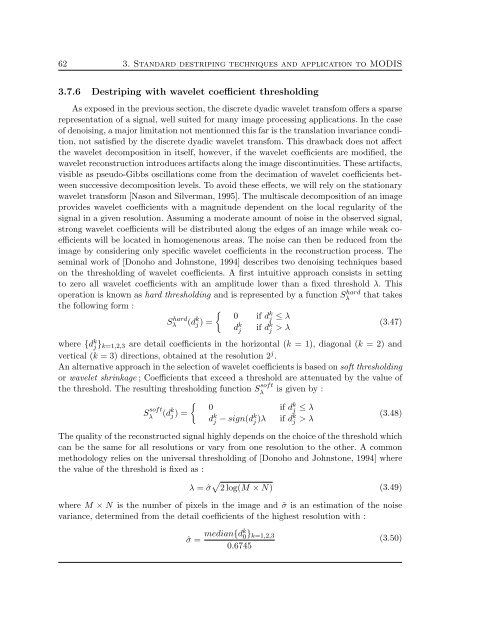Th`ese Marouan BOUALI - Sites personnels de TELECOM ParisTech
Th`ese Marouan BOUALI - Sites personnels de TELECOM ParisTech
Th`ese Marouan BOUALI - Sites personnels de TELECOM ParisTech
Create successful ePaper yourself
Turn your PDF publications into a flip-book with our unique Google optimized e-Paper software.
62 3. Standard <strong>de</strong>striping techniques and application to MODIS<br />
3.7.6 Destriping with wavelet coefficient thresholding<br />
As exposed in the previous section, the discrete dyadic wavelet transfom offers a sparse<br />
representation of a signal, well suited for many image processing applications. In the case<br />
of <strong>de</strong>noising, a major limitation not mentionned this far is the translation invariance condition,<br />
not satisfied by the discrete dyadic wavelet transfom. This drawback does not affect<br />
the wavelet <strong>de</strong>composition in itself, however, if the wavelet coefficients are modified, the<br />
wavelet reconstruction introduces artifacts along the image discontinuities. These artifacts,<br />
visible as pseudo-Gibbs oscillations come from the <strong>de</strong>cimation of wavelet coefficients between<br />
successive <strong>de</strong>composition levels. To avoid these effects, we will rely on the stationary<br />
wavelet transform [Nason and Silverman, 1995]. The multiscale <strong>de</strong>composition of an image<br />
provi<strong>de</strong>s wavelet coefficients with a magnitu<strong>de</strong> <strong>de</strong>pen<strong>de</strong>nt on the local regularity of the<br />
signal in a given resolution. Assuming a mo<strong>de</strong>rate amount of noise in the observed signal,<br />
strong wavelet coefficients will be distributed along the edges of an image while weak coefficients<br />
will be located in homogenenous areas. The noise can then be reduced from the<br />
image by consi<strong>de</strong>ring only specific wavelet coefficients in the reconstruction process. The<br />
seminal work of [Donoho and Johnstone, 1994] <strong>de</strong>scribes two <strong>de</strong>noising techniques based<br />
on the thresholding of wavelet coefficients. A first intuitive approach consists in setting<br />
to zero all wavelet coefficients with an amplitu<strong>de</strong> lower than a fixed threshold λ. This<br />
operation is known as hard thresholding and is represented by a function S hard that takes<br />
the following form :<br />
{ 0 if d<br />
Sλ hard (d k k<br />
j )=<br />
j ≤ λ<br />
d k j if d k j >λ (3.47)<br />
where {d k j } k=1,2,3 are <strong>de</strong>tail coefficients in the horizontal (k = 1), diagonal (k = 2) and<br />
vertical (k = 3) directions, obtained at the resolution 2 j .<br />
An alternative approach in the selection of wavelet coefficients is based on soft thresholding<br />
or wavelet shrinkage ; Coefficients that exceed a threshold are attenuated by the value of<br />
the threshold. The resulting thresholding function S soft<br />
λ<br />
is given by :<br />
{<br />
S soft<br />
0 if d<br />
λ<br />
(d k k<br />
j )=<br />
j ≤ λ<br />
d k j − sign(dk j )λ if dk j >λ (3.48)<br />
The quality of the reconstructed signal highly <strong>de</strong>pends on the choice of the threshold which<br />
can be the same for all resolutions or vary from one resolution to the other. A common<br />
methodology relies on the universal thresholding of [Donoho and Johnstone, 1994] where<br />
the value of the threshold is fixed as :<br />
λ =ˆσ √ 2 log(M × N) (3.49)<br />
where M × N is the number of pixels in the image and ˆσ is an estimation of the noise<br />
variance, <strong>de</strong>termined from the <strong>de</strong>tail coefficients of the highest resolution with :<br />
λ<br />
ˆσ = median{dk 0 } k=1,2,3<br />
0.6745<br />
(3.50)















